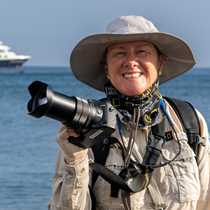Endicott Arm
When I first peeked out of the window this morning, the gray low clouds seemed to portend an end to the streak of sunny weather we have had the last few days. However, as the bergy bits became more frequent and the walls of the fiord steeper, the sky became bluer. A black bear feeding on barnacles and blue mussels provided the perfect excuse to wake everyone up well before breakfast; after all, it had been light since around four in the morning!
Sunshine made the small icebergs sparkle and the ice blue glow, so after breakfast when the ship could no longer advance, we used Zodiacs to approach Dawes glacier to within a half-mile. We gazed, we photographed and we tasted ice. Sculpted curves in blue walls of ice mimicked the sculpted curves in the granite walls above us. Dawes glacier had scraped the sides of this fiord just a few decades ago as it retreated. Crescentic chattermarks in stone and ice.
All around us was life. Harlequin ducks were spectacular in their outrageous breeding plumage; harbor seals were cryptic in theirs. Dark grey bowling-ball heads silently appearing between the brash ice, and as quickly disappearing when we look their way. The females are starting to pup on the ice near the glacier face – a safe place we do our best to stay away from, although the moving ice has them drifting around in slow sweeps from one side of the fiord to the other. Fresh water from the glacier and ocean salt water have differing densities which creates continual vertical currents that keep all in motion, bringing nutrients to the surface; combined with long daylight hours, plankton blooms prolifically.
John, a Wilderness Ranger who works this area paid us a visit by kayak, and we gave him a ride down-arm (and lunch) while he explained the work he does. Some of it entails helping us and other visitors to understand the incredible gift we have in our hands as citizens of this country. It comes with responsibilities, if we want to keep it as pristine as it was when first created.
A brown bear now showed itself grazing on meadow grasses along the shore; a large animal, blond fur around broad face and huge shoulders. He knew exactly where we were, but didn’t seem to mind the distant attention.
Walks in the rainforest this afternoon were adventures into a different world of large trees, mossy glades, bear trails and beaver public works. Most folks managed to bond with their boots, and they proved faithful repellants of water and mud during some of the hikes on shore. Since we haven’t had much rain, some trails were relatively dry, surprisingly enough. Kayakers practiced paddling in the late afternoon light, but finally we met on board, enjoying our home called the National Geographic Sea Lion.
When I first peeked out of the window this morning, the gray low clouds seemed to portend an end to the streak of sunny weather we have had the last few days. However, as the bergy bits became more frequent and the walls of the fiord steeper, the sky became bluer. A black bear feeding on barnacles and blue mussels provided the perfect excuse to wake everyone up well before breakfast; after all, it had been light since around four in the morning!
Sunshine made the small icebergs sparkle and the ice blue glow, so after breakfast when the ship could no longer advance, we used Zodiacs to approach Dawes glacier to within a half-mile. We gazed, we photographed and we tasted ice. Sculpted curves in blue walls of ice mimicked the sculpted curves in the granite walls above us. Dawes glacier had scraped the sides of this fiord just a few decades ago as it retreated. Crescentic chattermarks in stone and ice.
All around us was life. Harlequin ducks were spectacular in their outrageous breeding plumage; harbor seals were cryptic in theirs. Dark grey bowling-ball heads silently appearing between the brash ice, and as quickly disappearing when we look their way. The females are starting to pup on the ice near the glacier face – a safe place we do our best to stay away from, although the moving ice has them drifting around in slow sweeps from one side of the fiord to the other. Fresh water from the glacier and ocean salt water have differing densities which creates continual vertical currents that keep all in motion, bringing nutrients to the surface; combined with long daylight hours, plankton blooms prolifically.
John, a Wilderness Ranger who works this area paid us a visit by kayak, and we gave him a ride down-arm (and lunch) while he explained the work he does. Some of it entails helping us and other visitors to understand the incredible gift we have in our hands as citizens of this country. It comes with responsibilities, if we want to keep it as pristine as it was when first created.
A brown bear now showed itself grazing on meadow grasses along the shore; a large animal, blond fur around broad face and huge shoulders. He knew exactly where we were, but didn’t seem to mind the distant attention.
Walks in the rainforest this afternoon were adventures into a different world of large trees, mossy glades, bear trails and beaver public works. Most folks managed to bond with their boots, and they proved faithful repellants of water and mud during some of the hikes on shore. Since we haven’t had much rain, some trails were relatively dry, surprisingly enough. Kayakers practiced paddling in the late afternoon light, but finally we met on board, enjoying our home called the National Geographic Sea Lion.




